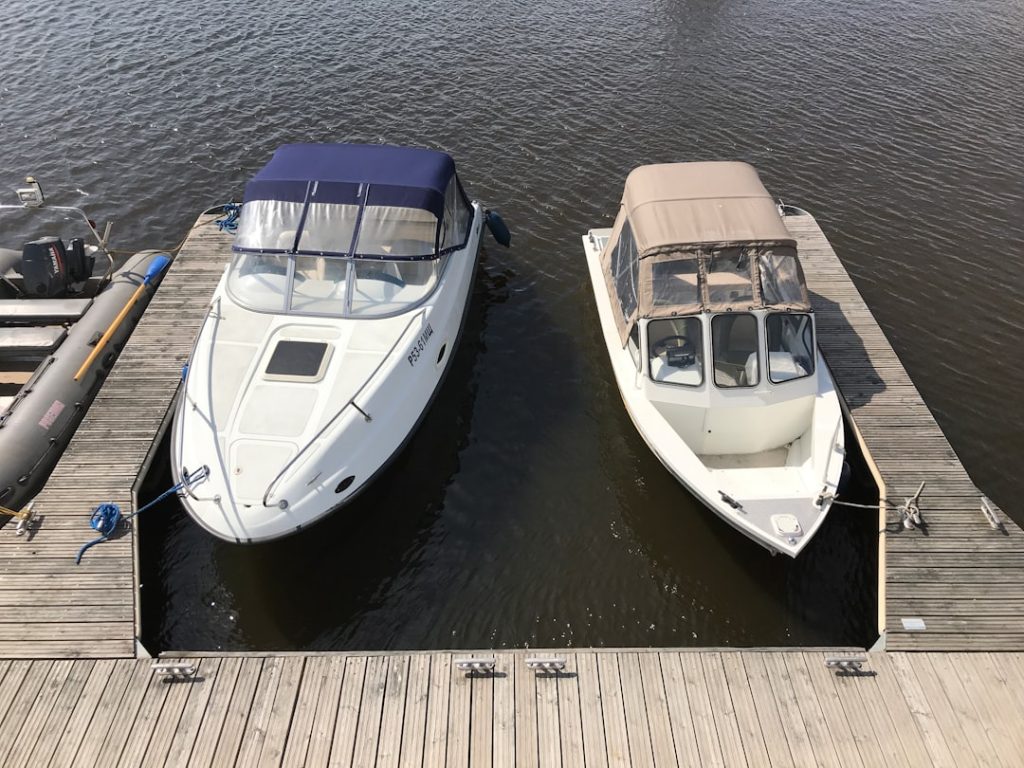When embarking on the journey to purchase a used patio boat, the first step is to clearly understand your needs and preferences. This involves considering how you plan to use the boat, who will be accompanying you, and the types of activities you envision enjoying on the water. For instance, if you are looking to host family gatherings or entertain friends, a larger boat with ample seating and amenities such as a grill or a wet bar may be essential.
Conversely, if your primary goal is to enjoy quiet afternoons fishing or relaxing on the water, a smaller, more streamlined model might suffice. Additionally, it’s crucial to think about the environment in which you will be using the boat. Will you primarily be navigating calm lakes, or do you plan to venture into more turbulent waters?
Understanding the conditions you’ll face can help you select a boat that is not only comfortable but also safe and suitable for your intended use. Factors such as stability, hull design, and engine power should all be considered in relation to your specific boating environment. By taking the time to assess your needs thoroughly, you can make a more informed decision that aligns with your lifestyle and boating aspirations.
Key Takeaways
- Identify your boating needs to choose the right patio boat for your lifestyle.
- Research various used patio boat types to find the best match and value.
- Set a realistic budget before shopping to avoid overspending.
- Thoroughly inspect used boats for condition and potential issues before buying.
- Understand financing, registration, and insurance requirements to ensure smooth ownership.
Researching Available Options: Exploring Different Types of Used Patio Boats
Once you have a clear understanding of your needs, the next step is to explore the various types of used patio boats available on the market. Patio boats, often referred to as pontoon boats, come in a range of styles and configurations, each designed for different purposes. For example, some models are specifically designed for leisure cruising, featuring spacious decks and comfortable seating arrangements, while others may be equipped for water sports, complete with tow bars and storage for equipment.
In addition to style and purpose, it’s important to consider the size of the boat. Patio boats can vary significantly in length and width, affecting their capacity and maneuverability. A larger boat may accommodate more passengers but could also be more challenging to handle in tight spaces or during docking.
Furthermore, researching brands and manufacturers can provide insight into reliability and performance. Some brands are known for their durability and quality craftsmanship, while others may have a reputation for frequent repairs or maintenance issues. By conducting thorough research on available options, you can narrow down your choices to those that best fit your requirements.
Setting a Budget: Determining How Much You Can Afford to Spend

Establishing a budget is a critical step in the process of purchasing a used patio boat. This involves not only determining how much you are willing to spend on the initial purchase but also considering ongoing costs such as maintenance, insurance, fuel, and storage. A common mistake among first-time buyers is focusing solely on the purchase price without accounting for these additional expenses.
For instance, while a used boat may seem like a bargain at first glance, high maintenance costs or expensive repairs can quickly turn that deal into a financial burden. To set a realistic budget, it’s advisable to conduct research on the average prices of used patio boats in your area. Websites that specialize in boat sales often provide listings with price ranges based on condition, age, and features.
Additionally, consider whether you will be paying in cash or financing the purchase. If financing is necessary, it’s important to factor in interest rates and loan terms when calculating your overall budget. By taking a comprehensive approach to budgeting, you can ensure that your boat purchase remains within your financial means while still meeting your needs.
Inspecting Used Boats: What to Look for When Examining Potential Purchases
| Inspection Area | What to Look For | Common Issues | Recommended Action |
|---|---|---|---|
| Hull | Check for cracks, blisters, and soft spots | Structural damage, water intrusion | Inspect thoroughly; consider professional survey |
| Engine | Look for leaks, corrosion, and unusual noises | Poor maintenance, mechanical failure | Request maintenance records; test run engine |
| Electrical System | Test all electronics and wiring for functionality | Faulty wiring, dead batteries | Check battery condition; inspect wiring connections |
| Deck and Hardware | Inspect for loose fittings, rust, and wear | Corrosion, weakened fittings | Tighten or replace hardware as needed |
| Interior | Look for mold, mildew, and water damage | Leaks, poor ventilation | Check seals and ventilation systems |
| Steering System | Check for smooth operation and no play | Stiff or loose steering | Inspect cables and hydraulic lines |
| Safety Equipment | Verify presence and condition of life jackets, fire extinguishers | Expired or missing equipment | Replace or update safety gear |
| Documentation | Review registration, title, and maintenance records | Missing or unclear paperwork | Confirm ownership and service history |
When it comes time to inspect potential used patio boats, knowing what to look for can make all the difference in ensuring a sound investment. Start by examining the exterior of the boat for any signs of damage or wear. Look for scratches, dents, or signs of corrosion on the hull, as these can indicate neglect or poor maintenance.
Additionally, check the condition of the upholstery and flooring; faded or torn materials may suggest that the boat has been exposed to harsh elements without proper care. Beyond visual inspections, it’s also essential to assess the mechanical components of the boat. This includes checking the engine for any leaks or unusual noises during operation.
If possible, request a test drive to evaluate how the boat handles on the water. Pay attention to how smoothly it accelerates and whether there are any vibrations or steering issues. Furthermore, inquire about the boat’s maintenance history; a well-documented service record can provide reassurance regarding its condition and reliability.
By conducting a thorough inspection, you can identify potential red flags that may warrant further consideration before making a purchase.
Negotiating the Purchase: Tips for Getting the Best Deal on a Used Patio Boat
Negotiating the price of a used patio boat can be an intimidating process for many buyers; however, with the right approach, it can also be an opportunity to secure a better deal. Start by doing your homework on comparable models in your area to establish a baseline price range. This knowledge will empower you during negotiations and provide leverage if you encounter an asking price that seems inflated.
When entering negotiations, it’s important to remain calm and composed. Begin by expressing genuine interest in the boat while also highlighting any concerns you may have discovered during your inspection. For example, if you noticed cosmetic damage or mechanical issues, use these points as bargaining chips to justify a lower offer.
Additionally, be prepared to walk away if the seller is unwilling to meet your price; this demonstrates that you are serious about sticking to your budget and can often prompt sellers to reconsider their stance. Ultimately, effective negotiation requires patience and persistence but can lead to significant savings on your purchase.
Financing Options: Exploring Ways to Finance Your Used Boat Purchase

Financing a used patio boat can open up opportunities for buyers who may not have sufficient cash on hand for an outright purchase. There are several financing options available that cater specifically to boat buyers. Traditional bank loans are one option; however, they often require good credit scores and may come with stringent terms.
Alternatively, credit unions may offer more favorable rates and terms for their members. Another popular financing avenue is through specialized marine lenders who focus exclusively on recreational vehicles like boats. These lenders typically have more flexible criteria and may offer loans tailored specifically for used boats.
It’s also worth exploring dealer financing options if purchasing from a dealership; they may have partnerships with lenders that can provide competitive rates or promotional offers. Regardless of which financing route you choose, it’s crucial to carefully review all terms and conditions before committing to ensure that you fully understand your obligations.
Registering and Insuring Your Boat: Navigating the Legalities of Boat Ownership
Once you’ve successfully purchased your used patio boat, navigating the legalities of ownership becomes paramount. The first step is registering your boat with your state’s boating authority or department of motor vehicles (DMV). Registration requirements vary by state but typically involve providing proof of ownership through documentation such as a bill of sale or title transfer.
Additionally, many states require boats to display registration numbers prominently on their hulls. Insurance is another critical aspect of boat ownership that should not be overlooked. Just as with automobiles, having adequate insurance coverage protects you from potential liabilities while on the water.
When selecting an insurance policy for your patio boat, consider factors such as coverage limits, deductibles, and specific protections like liability coverage or coverage for theft and damage. It’s advisable to shop around and compare quotes from multiple insurers to find a policy that meets your needs at a reasonable cost.
Enjoying Your New Patio Boat: Tips for Making the Most of Your Purchase
With all the groundwork laid out—from understanding your needs to navigating legalities—it’s time to enjoy your new patio boat fully. One of the best ways to maximize your experience is by familiarizing yourself with its features and capabilities. Spend time learning how everything works—from operating the engine and navigation systems to utilizing onboard amenities like sound systems or cooking facilities.
This knowledge will enhance your confidence while out on the water. Additionally, consider joining local boating clubs or communities where you can connect with fellow enthusiasts who share similar interests. These groups often organize events such as group outings or fishing tournaments that can enrich your boating experience while providing opportunities for socializing and networking.
Moreover, don’t forget about safety; always ensure that you have life jackets onboard and familiarize yourself with local boating regulations before heading out. By embracing both the practical aspects of boating and the community surrounding it, you can create lasting memories with friends and family while enjoying all that your new patio boat has to offer.


